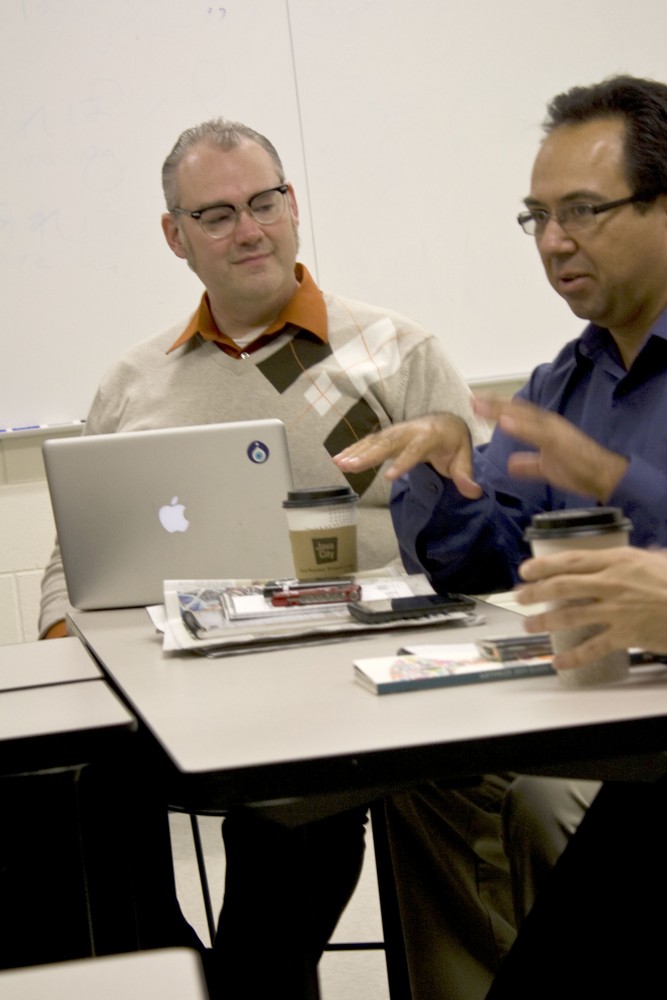Twitter, Facebook new course ‘requirements’

GVL / Kate Kaurich Professor Brian Bowe listens intently to guest speaker.
Sep 22, 2011
In March 2011, the Grand Valley State University Social Media Committee surveyed faculty, staff, alumni and students on campus in regards to their social media habits and practices.
The results, released in early September, suggest that as social networking has become an increasingly prevalent mean of information in society, and teachers are slowly incorporating it into GVSU classes.
Brian Bowe, a journalism professor and social media committee member at GVSU, came up with the idea for the Social Media Survey with a colleague, D. Yvette Wohn, in his doctorate program in Media and Information Studies at Michigan State University.
“The idea for the survey arose out of their desire to discover what it means when people read news not strictly from a news network but filtered through their social network friends,” Bowe said. “They are continuing to comb through the data and hope to produce even more results within the next few months.”
Bowe is an advocate of using social networking in classes. He tweets, updates and checks in (he has Twitter, Facebook and Foursquare accounts) — and he makes sure his students do too. In one of his classes, Art and Music Criticism, Bowe had his students create a Twitter account to follow prominent art critics and have discussions about the arts.
“I think it’s really important to try to communicate with students in ways that are meaningful to them… It’s very clear to me that social media is a powerful way of interacting with students,” Bowe said.
According to the GVSU Social Media Survey results, 94 percent of participants have Facebook accounts, whereas only 31.4 percent have a Twitter account. In the survey, 88 percent of participants said they use social networking at least once a day, and of those who use Twitter, only 13 percent use it for professional networking.
“I think that people who use Twitter tend to think that more people use it more than they actually do,” he said. “I find there’s still a significant amount of people that don’t use Twitter or don’t know how to use it. I think I need to spend more time on that. I have units planned on techniques for using it.”
Bowe, who has been teaching at GVSU for 11 years, learned early on in his teaching career the importance of connecting with students on a social level. Over the years, he has adopted several uses for social networking in classes.
“One of the things I’ve noticed right away is that it allows me to stay in contact with students in a less formal way and it’s really cool to have students tweeting things about class back to me without me even saying anything,” he said.
Bowe said there are some noticeable drawbacks to social networking in classrooms, though. When he has classes in lab settings, he notices that many students are on Facebook the whole time.
“I try to not blame the technology. What I try to do is instead ask myself: ‘Is there a research task we can use this technology source for since it’s sitting right there?’” he said.
Other professors at GVSU do not have such a willingness to incorporate social networking into their classes. Michael Webster, an English professor, is one of many professors that uphold the viewpoint that social networking belongs outside the classroom.
“Social networking is just that: social,” he said. “A class, on the other hand, has more serious goals than just making connections and posting updates. Moreover, social networking, while social, seems too cumbersome and electronic to me. I prefer the give and take and human interaction that occurs with face-to-face discussion in a classroom full of people who can see one another’s facial expressions and hear tone of voice.”
Despite the potential drawbacks for using social networking in class, Bowe still advocates it and believes social networking holds value in enhancing the dialogue between teacher and students.
“By the time we get to a college level, learning takes place best when it happens in dialogue and social media provides one avenue where it’s all about dialogue,” he said. “So when you can have some good interactions going back and forth, both the student and teacher are co-creating this learning space.”
In the debate between the benefits and drawbacks of using social networking in class, Bowe provides a happy medium.
“Technology is neither inherently good nor bad—it’s what you do with it,” he said.

























